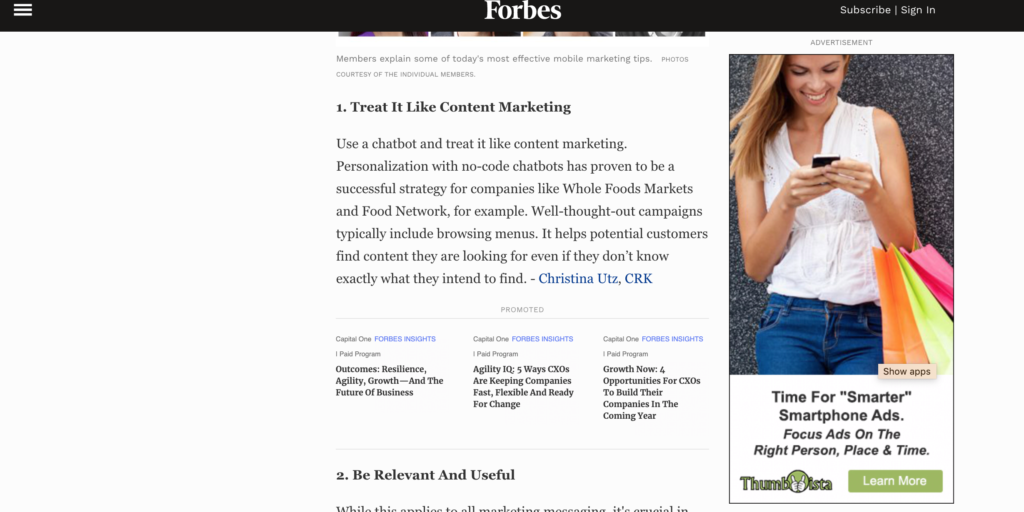Contextual advertising may sound new but it is one of the oldest forms of advertising. Almost all media channels provide a form of contextual advertising. For example, on The Golf Channel you will see golfing products or locations to play same goes with magazine Golf Digest. Contextual targeting for digital advertising is to place advertising based on the content of a page. For example; you advertise oven mitts on a cooking site or advertise sleeping bags on a popular camping blog. By using programmatic buying you can select the digital category that is relevant to the product or service.
How Contextual Targeting Works – Technically
Web crawlers from various advertising inventory providers scan a webpages content and then classifies into a category. This makes sense for sites the cover a variety of topics. Also Inventory providers (supply side platforms) request sites or apps to identify what their content is about when they place software on the page. Categories are classified by app store or the IAB. This is for trustworthiness and ad targeting.
Benefits Of Contextual Targeted Advertising
With new privacy standards effecting 3rd party cookies contextual targeting is 100% privacy safe. The easy way to find someone for your product is to know what else they would be interested in and advertising there. This is great for niche marketers or those who know exactly who their perfect customer would be.
How it Differs from Behavioral Advertising
Behavioral targeting is based on previous actions. A website, keyword search or location visited. Retargeting is technically a for of behavioral targeting. Contextual targeting is more real time and is privacy friendly.

How To Purchase Contextually Targeted Advertising.
Many DSPs (demand side platforms) offer the ability to target contextually. Hiring the professionals at Thumbvista is the best choice. We can help with every step of the way including, topic research, ad design and premium placements.
Examples of Contextual Relevance in Action
Nike’s Contextual Advertising Triumph
In a notable example, Nike employed programmatic contextual advertising during major sporting events. Leveraging real-time data and contextually relevant triggers, Nike dynamically adjusted its ad creatives to align with the specific events and athletes captivating global audiences. This strategic move resulted in a surge of engagement and conversions as users encountered personalized and timely messages tailored to their current interests and the ongoing sports narrative.
**Key Takeaway:** Nike’s success demonstrates the effectiveness of aligning programmatic contextual advertising with real-time events, ensuring heightened relevance and consumer engagement.
Airbnb’s Hyper-Local Campaigns
Airbnb utilized programmatic contextual advertising to target users with hyper-localized campaigns. By analyzing user behaviors, search patterns, and location data, Airbnb dynamically adjusted its ad content to showcase available accommodations, experiences, and promotions specific to the user’s current location or recent searches. This personalized approach significantly increased user engagement and conversion rates, as potential customers were presented with highly relevant offerings based on their immediate context.
**Key Takeaway:** Airbnb‘s example highlights the power of programmatic contextual advertising in delivering hyper-personalized content based on user behaviors and local context.
Coca-Cola’s Seasonal Messaging
Coca-Cola implemented programmatic contextual advertising to align its messaging with seasonal and weather-related triggers. During hot summer days, Coca-Cola dynamically adjusted its ad creatives to emphasize refreshing, cold beverages, while during winter, the focus shifted to cozy and festive themes. By adapting to contextual cues, Coca-Cola successfully captured the mood of its audience, resulting in increased engagement and product consideration during specific seasons.
**Key Takeaway:** Coca-Cola’s approach showcases the versatility of programmatic contextual advertising, allowing brands to tailor messages based on seasonal shifts and weather conditions, enhancing consumer resonance.
These examples underscore the flexibility and effectiveness of programmatic contextual advertising when strategically aligned with real-time events, user behaviors, and contextual triggers. By staying agile and leveraging dynamic content adjustments, brands can create highly relevant and engaging ad experiences for their target audience.

